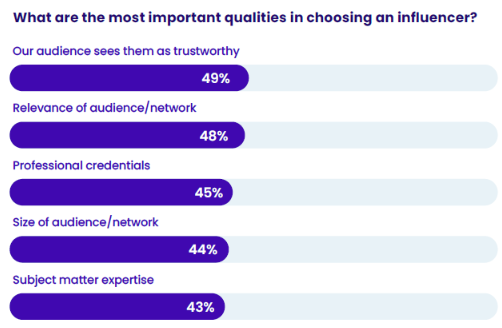Have you noticed familiar names popping up in the comments of every single one of your favorite accounts’ social media posts?
Perhaps this person has an unhealthy infatuation with the creator or thought leader’s online presence, or maybe they’re a highly-trained bot. While both could be true, there’s another, more harmless possibility. I’m referring to influencer pods.
What are influencer pods?
No, influencer pods aren’t some new and trendy earbuds made exclusively for today’s top brand ambassadors. Rather, the term refers to groups of social media users who engage with each other’s content via a quid pro quo relationship. The overall gist? You like, repost, comment on my social posts, and I’ll do the same for you. It’s really that simple.
How do influencer pods work?
How often do you see creators and thought leaders asking followers explicitly to comment, like, and repost their work? It’s not uncommon, but why issue a public call to action for engagement when you can make a concerted effort to farm engagement in a mostly private group?
Influencer pods form and communicate on the very platforms they intend to operate on, with groups most often appearing on Facebook and even LinkedIn. However, influencer pods aren’t limited to these large, mostly public communities. Sometimes, smaller groups are moved off-platform to private apps such as WhatsApp, Telegram, Discord, and Slack.
Like an exclusive group with benefits, there are some rules. The first rule of influencer pods clubs? Don’t talk about influencer pods clubs. Just kidding, mostly. While each group of these like-for-likers differ, they share a similar set of guidelines. Usually, they’re duty-bound to engage with a certain number of pieces of content a day within a certain timeframe. Failure to do so may result in participants being removed from the engagement group
The perceived advantages of influencer pods
Users have a lot to gain from influencer pods. Let’s take a look at some of the benefits they may enjoy by participating:
- The algorithm advantage: While no algorithm has been completely unlocked, savvy social users noticed many social platforms prioritize content with high engagement.
- Networking: Those in pods are often in the same industry, an obvious road to relationship building and idea sharing.
- Reach new users: Reposts from those in the same industry can help influencers reach new, relevant audiences.
- New opportunities: Higher perceived engagement may result in outreach from a brand that uncovered your content.
The perceived downsides of influencer pods
Perception isn’t always reality. Users who engage in influencer pods may see diminishing returns for their efforts, along with reputational implications:
- No likes for you: Algorithms may catch on to activity perceived as suspicious and flag content, diminishing reach and in turn engagement.
- Is this (in)organic?: Large fluctuations in engagement from pod members may push users to ask, “Is this bot activity?”
- Liking “unlikeable” content: Pod members often have to engage with content they don’t enjoy.
- Repost mania: A feed of constant reposts, which often make it difficult for original content to be found, can be unattractive to brands and audiences.
How to identify an influencer pod
If your brand is considering collaborating with a new creator, it’s important to know if they’re involved in an influencer pod. As of now, there’s no magical formula, nor is there a tool that can detect pod behavior across all channels. That being said, influencer marketing programs like Klear can detect pod activity on some channels.
If you don’t want to depend on software, much can be gleaned from simply reviewing an influencer’s social media activity. On LinkedIn and X, we recommend scrolling through their profile as well as the replies/comments sections. Look for:
- Reposts: Are they reposting several pieces of the same content from the same users? Check that user profile for similar behavior.
- Comments: Do they engage with content from other influencers? Is it a regular occurrence?
- Tagging: Check to see original poster is tagging multiple (in many cases several) influencers in their post.
Should you work with those participating in influencer pods?
More and more audiences rely on influencers to help guide their purchasing decisions – but brands often only see meaningful results from influencers who have one key quality: trustworthiness. And marketers agree; research from our 2023 Influencer Marketing Report found that this trait is most important when choosing an influencer.

If you’re considering an influencer who appears to be engaged in an influencer pod, ask yourself, is their social presence genuine? If the way they engage with their audience feels inauthentic, what does that say about their role as a thought leader/creator? How could their activity on social media impact the image of your brand? Are they being propped up solely by coordinated engagement from their peers?
Do note that working with influencers who participate in influencer pods isn’t necessarily always a bad thing. Those who engage with others on a seemingly routine basis in an authentic manner should be considered, especially if the influencers are creating true thought leadership. At the end of the day, influencer pods can only take users so far. The road to consistent engagement and visibility starts with creating quality, authentic, and impactful content.
Identifying and vetting influencers is an arduous task that must be done with great care, especially with the proliferation of influencer pods. Let us handle the leg work. Ask us about our influencer marketing services today and we’ll help you discover authentic influencers capable of delivering real results for your brand.
About the author
Alex White is the Social – Influencer Lead at TopRank Marketing and a proud U.S. Navy veteran. He leverages his industry experience to build deep, authentic relationships with today’s top B2B influencers, always delivering exceptional campaign results for a variety of Fortune 1000 brands. Alex’s approachable nature and can-do attitude regularly makes him a client favorite to work with, and our team agrees.

Comments are Closed